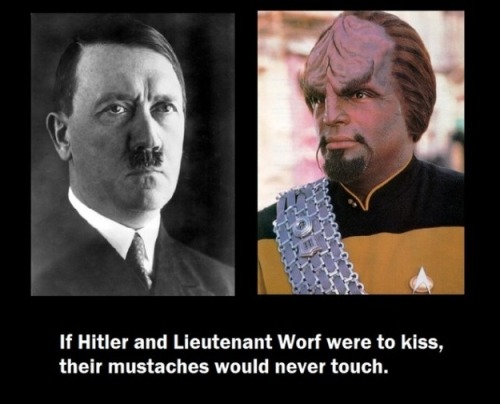Posts Tagged → nazi
Hairless Kiss with facial hair Achieved

like 2 puzzle pieces, destined to connect…
Reluctant Hitler Puppy Obeys

le sigh… le heil… le woof
Half a Heart

I bet you did Nazi this coming
Work = Freedom
 “Arbeit macht frei” is a German phrase meaning “work brings freedom” or “work shall set you free/will free you” or “work liberates” and, literally in English, “work makes (one) free”. The slogan is known for being placed at the entrances to a number of Nazi concentration camps.
“Arbeit macht frei” is a German phrase meaning “work brings freedom” or “work shall set you free/will free you” or “work liberates” and, literally in English, “work makes (one) free”. The slogan is known for being placed at the entrances to a number of Nazi concentration camps.
The slogan “Arbeit macht frei” was placed at the entrances to a number of Nazi concentration camps “as a kind of mystical declaration that self-sacrifice in the form of endless labor does in itself bring a kind of spiritual freedom.”
Although it was common practice in Germany to post inscriptions of this sort at entrances to institutional properties and large estates, the slogan’s use in this instance was ordered by SS General Theodor Eicke, inspector of concentration camps and first commandant of Dachau Concentration Camp.
The slogan can still be seen at several sites, including the entrance to Auschwitz I—although, according to Auschwitz: a New History, by BBC historian Laurence Rees, it was placed there by commandant Rudolf Höß, who believed that doing menial work during his own imprisonment under the Weimar Republic had helped him through the experience. At Auschwitz, the upper bowl in the “B” in “ARBEIT” is wider than the lower bowl, appearing to some as upside-down. Several geometrically constructed sans-serif typefaces of the 1920s experimented with this variation.
The slogan can also be seen at the Dachau concentration camp, Gross-Rosen concentration camp, Sachsenhausen, and the Theresienstadt Ghetto-Camp.
At Buchenwald, however, “Jedem das Seine” (literally, “to each his own”, but figuratively “everyone gets what he deserves”) was used instead.
In 1938 the Austrian political cabaret writer Jura Soyfer and the composer Herbert Zipper, while prisoners at Dachau Concentration Camp, wrote the “Dachaulied” (The Dachau Song). They had spent weeks marching in and out of the camp’s gate to daily forced labour, and considered the motto “Arbeit macht frei” over the gate an insult. The song repeats the phrase cynically as a “lesson” taught by Dachau. (The first verse is translated in the article on Jura Soyfer.)
Frank & Pfeffer
Things can get a little testy when you’re crammed into a small living space for months on end while hiding from the Nazi’s. This was the case with Anne Frank and Fritz Pfeffer. Of all the stressful relationships precipitated by living in such close proximity with each other for two years, the relationship between Anne and Pfeffer was one of the most difficult for both, as her diary shows.
 In November, 4 months into the Frank familys hiding, they were joined by Fritz Pfeffer, a dentist and friend of the family. Anne wrote of her pleasure at having new people to talk to, but tensions quickly developed within the group forced to live in such confined conditions. After sharing her room with Pfeffer, she found him to be insufferable and resented his intrusion, and she clashed with Auguste van Pels, whom she regarded as foolish.
In November, 4 months into the Frank familys hiding, they were joined by Fritz Pfeffer, a dentist and friend of the family. Anne wrote of her pleasure at having new people to talk to, but tensions quickly developed within the group forced to live in such confined conditions. After sharing her room with Pfeffer, she found him to be insufferable and resented his intrusion, and she clashed with Auguste van Pels, whom she regarded as foolish.
Pfeffer was added to the 2 families already hiding int he secret annex after in inquiring to Miep Giess, one of the office workers who brought the hidden families food and supplies, on a place to hide. He had thought the Franks escaped to Switzerland, as was the rumor they had left before going into hiding and was surprised to see them in the attic when he arrived. Anne and Pfeffer (pronounced “Feffer” which makes for a pimp name) shared a room under the logic that Anne was just a child, so that was the best matchup, but they clashed due to Anne going through puberty while sharing a room with a middle aged man and they argued over who got to use the desk in the room, among other things. I mention the desk thing though because Pfeffer was annoyed at the very premise that Anne would need to use the desk for her silly girlish writings while he was conducting “important work” like studying Spanish and writing letters to his girlfriend – the latter, admittedly being personally important, but a case of dramatic irony nonetheless, considering the massive importance Anne’s writings would become.
Pfeffer is given the pseudonym Mr Dussel (meaning “Mr Nitwit”) in Anne’s Diary. Mr Dussel is played by comedic actor Ed Wynn in the 1959 movie:
Charlotta married Pfeffer posthumously in 1950, with retrospective effect to 31 May 1937. She had become estranged from his son Werner but both were united in their defense of Pfeffer after the publication of Anne Frank’s diary in 1947, feeling that Anne’s portrait of him—and of the pseudonym she had chosen for him, Mr. Dussel, which in German is “Mr. Nitwit”—was injurious to his memory. Otto Frank tried to placate them by reminding them of Anne’s youth and of the unflattering portraits of some of the other people in hiding. The subsequent exaggerations of this portrait in the 1955 play and 1959 movie led Charlotta to contact the screenwriters Albert Hackett and his wife Frances Goodrich to complain that they were libelling her deceased husband, who was depicted as ignorant about Jewish traditions. The Hacketts replied that their script did not mirror reality and that to inform a non-Jewish audience of the significance of Judaic ceremonies one character had to be ignorant of them. Charlotta pointed out that her husband was far from unbelieving and a master of Hebrew, but the character of “Mr. Dussel” remained unchanged.
Embittered by the unrepresentative portrait, she severed her links with Otto Frank and Miep Gies as Anne’s fame grew in the decades after the war, and refused requests to be interviewed about her memories of him.
Werner remained in touch with Otto and had the opportunity to meet Miep shortly before he died of cancer in 1995, to thank her for her attempt to save his father’s life. The meeting between Miep and Werner was recorded for the documentary film Anne Frank Remembered.
A collection of letters written by Pfeffer to Charlotta and a box of photographs of him were rescued with some of Charlotta’s possessions from an Amsterdam flea market after her death in 1985.
DEATHS:
On the morning of August 4th 1944, the secret attic was stormed by the German Security Police following a tip-off from an informer who was never identified and all the families were deported to concentration camps.
With the rest of the group and two of their protectors, Johannes Kleiman and Victor Kugler, Pfeffer was taken to the Nazi headquarters in Amsterdam-South, then to a prison for three days before being transported to Westerbork on 8 August. Pfeffer was taken to the Punishment Barracks with the others, where he undertook hard labour, until he was selected for deportation to Auschwitz on 3 September. He was separated from the others on arrival on 6 September and sent to the men’s barracks, where he was reunited with Otto Frank. On 29 October he was transferred with 59 other medics to Sachsenhausen and from there to Neuengamme concentration camp on an unknown date, where he died on December 20th 1944 of according to the camp’s records, enterocolitis, a catch-all term that covered, among other things, dysentery, which was a common cause of death in the camps.
In March 1945, a typhus epidemic spread through the camp and killed approximately 17,000 prisoners. Witnesses later testified that Anne died of the disease 3 days after her sister. They stated that this occurred a few weeks before the camp was liberated by British troops on 15 April 1945, although the exact dates were not recorded.


